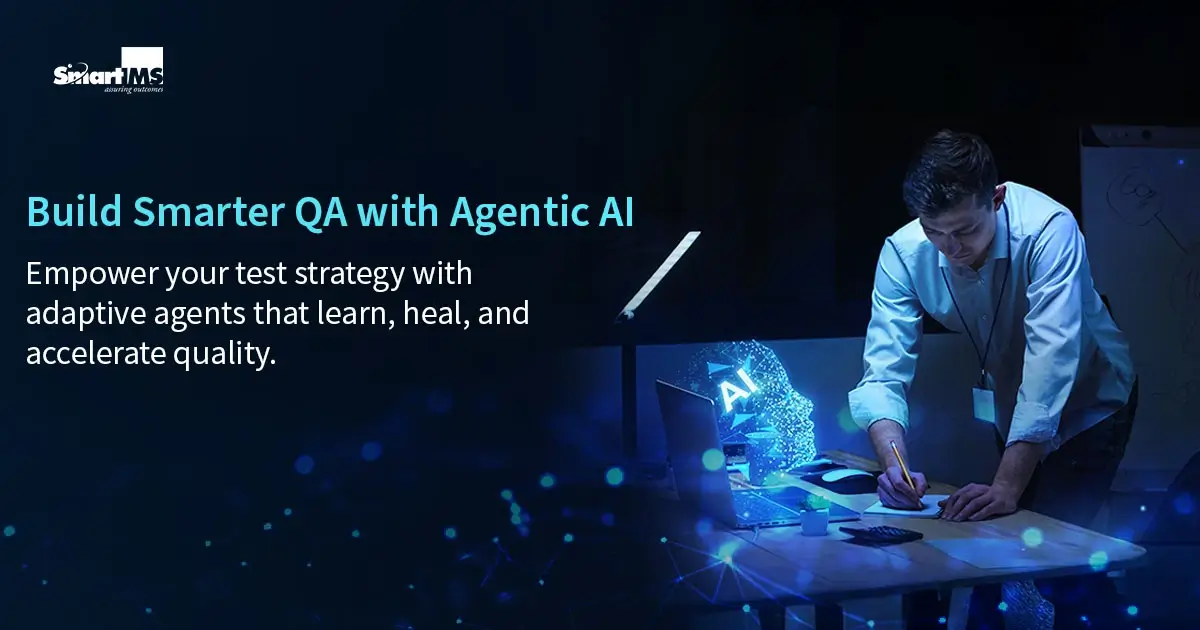Digital innovation is accelerating like never before, and with it comes the demand for faster, smarter, and more resilient software delivery. Testing remains at the heart of this effort, ensuring that quality keeps pace with speed. While automation brought significant gains in the past, it now struggles to keep up with modern complexities. Scripts break, test data becomes outdated, and teams spend more time troubleshooting than progressing.
What if testing could adapt on its own?
What if intelligent agents could navigate your application, learn its behavior, and validate outcomes like a real user would?
This is not a far-off concept. It is the emerging reality of Agentic AI, a shift that is transforming how software quality is achieved. And it’s a change that forward-thinking organizations are already embracing.
Let’s start.
The Unseen Anchor: Why Traditional Test Automation is Failing Us?
Traditional test automation, built on frameworks like Selenium, Cypress, etc., was a revolutionary step up from manual testing. It allowed teams to codify test cases into scripts that could be executed consistently and at scale. However, in today’s environment of dynamic user interfaces and rapid, continuous deployment (CI/CD), this model is beginning to reveal its limitations. Static scripts struggle to keep pace with ever-changing applications, often requiring constant updates and manual oversight.
The core problem is that scripts are inherently unintelligent. They are a set of rigid, pre-programmed instructions. When a developer changes a button’s ID, rewrites a user flow, or pushes a minor UI update, the script breaks. The result is a cascade of failures:
- Endless Maintenance: Engineering teams spend an estimated 30-40% of their time fixing and maintaining existing test suites instead of building new features.
- Flaky Tests: Tests fail for inconsistent reasons, eroding developer trust and leading to a culture where failing builds are ignored, defeating the purpose of CI/CD.
- Slow Velocity: The testing phase remains a significant bottleneck. The fear of breaking the fragile test suite often slows down innovation and delays time-to-market.
- Superficial Coverage: Scripts are excellent at validating the known “happy paths” but are woefully inadequate at discovering unexpected, edge-case bugs, the very kind that frustrates real users and impacts revenue.
This model is not sustainable. To win in the digital economy, you don’t just need to be fast; you need to be fast and deliver flawless quality. This requires new intelligence.
Now, let’s understand why Agentic AI in testing is the new era.
The Paradigm Shift: From Brittle Scripts to Intelligent Agents
Enter Agentic AI. Instead of writing a detailed script telling the machine how to test, you give an AI agent a high-level goal, and it figures out the rest.
Think of it this way:
- Traditional Automation is a Recipe: It’s a list of precise instructions. If an ingredient or a step changes, the recipe fails.
- Agentic AI is a Chef: You tell the chef the desired outcome (“Prepare a five-star Italian meal”). The chef uses their knowledge, skills, and senses to select the ingredients, adapt to the kitchen environment, and create the final dish.
Key Capabilities of Agentic AI in Testing
1. Goal-Driven Test Case Generation
Agentic systems can generate new test cases dynamically based on specific objectives such as maximizing coverage, reducing risk, or validating a recent code change. These agents analyze application structure, user behavior, and historical data to produce targeted tests that evolve with the product.
2. Autonomous Exploration and Discovery
Instead of following pre-scripted paths, agentic testers autonomously explore the application’s UI and API layers. They can uncover hidden workflows, edge cases, or integration gaps that are often missed in static testing.
3. Adaptive Test Execution
When a test fails due to minor UI or API changes, traditional systems mark it as failed. Agentic AI can reason through the failure, understand the context, and adapt its behavior to continue testing. This reduces flaky test results and unnecessary interruptions in CI/CD pipelines.
4. Continuous Learning from Feedback
Agentic agents continuously refine their testing strategies by learning from outcomes. They monitor which test cases consistently detect issues, which ones are redundant, and where coverage gaps exist. This leads to smarter test suite optimization over time.
5. Intelligent Prioritization
Agentic AI prioritizes test cases based on factors like risk impact, code change frequency, or recent defects. This ensures that high-value areas are always tested first, helping teams make faster go or no-go decisions during release cycles.
6. Seamless Integration with DevOps
Agentic testing agents integrate effortlessly with DevOps toolchains. They can trigger tests on code check-ins, analyze logs and telemetry, and generate reports that explain why specific tests were chosen or adapted. This creates a transparent and explainable testing process.
Now, let’s understand,
Agentic AI in Different Phases of Software Testing
To understand the practical impact of Agentic AI, let’s follow a single, continuous example through the entire Software Testing Life Cycle (STLC). Our goal for the AI agent is simple: “Ensure a user can successfully search for, and purchase, the new ‘Aura Smartwatch’ on our e-commerce site.”
1. Requirement Analysis
An agent begins by ingesting all relevant information related to the goal. It parses user stories, design documents, and even UI mockups to build a comprehensive understanding of the expected functionality.
- Example: The agent scans the Jira ticket for a new smartwatch launch. It identifies key requirements: the user must be able to search for the watch, view its details page, add it to the cart, apply a promo code, and complete payment. It uses its vision capabilities to analyze the Figma mockup, noting the color, size, and placement of key buttons. It then flags a potential ambiguity: “The user story specifies a ‘NEWLAUNCH’ promo code but does not define the expected error message if an invalid code is used.” This provides immediate, actionable feedback before a single line of test code is written.
2. Test Planning
Based on its analysis, the agent formulates a dynamic test plan. It analyzes the codebase to identify high-risk areas (e.g., recently changed modules) and prioritizes test flows accordingly.
- Example: The agent analyzes the latest Git commits and discovers significant changes were made to the StripePaymentGateway It therefore decides to prioritize test paths involving credit card payments over PayPal. It also plans to allocate more exploratory time to the new, interactive “Customize Your Watch” widget on the product page, as it uses a component library with a history of past defects.
3. Test Case Design / Development
This is where the paradigm shift is most apparent. The agent does not generate rigid scripts. Instead, it creates a flexible execution model based on its goal, preparing to navigate the application intelligently.
- Example: The agent formulates an abstract test flow: Locate ‘Aura Smartwatch’ -> View Details -> Add to Cart -> Proceed to Checkout -> Apply Promo Code -> Complete Purchase. It also designs negative test cases, such as attempting to buy the watch with an expired credit card or trying to apply two different promo codes simultaneously. It is now ready to achieve these outcomes, not just follow steps.
4. Test Environment Setup
The agent ensures the test environment is correctly configured for the planned tests, provisioning data and validating prerequisites automatically.
- Example: Before execution, the agent queries the test database to confirm the “Aura Smartwatch” product is listed as “in-stock” and has a price. If not, it can trigger a pre-configured API call to seed the database with the necessary product data. It also verifies that a test user account exists and has a valid (dummy) address on file, creating one if needed.
5. Performance Testing
The agent can use insights from its functional exploration to design and execute more realistic performance tests.
- Example: During its initial exploration, the agent notices that the high-resolution video on the smartwatch product page loads slowly. It uses this insight to create a targeted performance test, simulating 500 users concurrently accessing that specific page to measure server response time and pinpoint the video-loading bottleneck under stress.
6. Test Execution
The agent executes its plan by navigating the application like a human, adapting to changes in real-time. This is where self-healing comes into play.
- Example: The agent starts the test run. It successfully finds the smartwatch but discovers a developer has changed the “Add to Cart” button’s ID. A traditional script would fail. The agent, however, visually identifies the button by its text, color, and position next to the price. It clicks the button, self-healing the test path, and seamlessly proceeds to checkout without human intervention.
7. Defect Reporting & Tracking
When a true failure is confirmed, the agent creates a detailed, context-rich bug report that accelerates diagnosis and resolution.
- Example: When applying the “NEWLAUNCH” promo code, the agent observes that the cart total does not update. It confirms this is a bug. It automatically creates a Jira ticket titled: “Critical Bug: ‘NEWLAUNCH’ promo code not applied to cart total for smartwatch purchase.” The ticket is auto-populated with a video recording of the failure, console logs showing a JavaScript error, and the exact API request and response, giving the developer all the information needed to fix it immediately.
8. Test Closure
Upon completion, the agent generates a comprehensive report summarizing its activities, providing dynamic insights into application quality and actual test coverage.
- Example: The agent generates a closure report showing that 98% of user flows related to purchasing the smartwatch were validated. It highlights the one critical bug found (promo code). The report includes a visual map of all the exploratory paths it took, revealing it also discovered and tested the “Share on Social Media” link on the order confirmation page, a feature that wasn’t in the original requirements but was validated anyway. This gives stakeholders a true measure of quality based on emergent, intelligent exploration.
Now, let’s read how we in Smart IMS will help you.
The Bridge to Tomorrow: How Smart IMS Helps You Implement Agentic AI
Knowing the destination is one thing; navigating the complex journey of technological adoption is another. Agentic AI is not just another tool to be installed; it’s a strategic capability that requires careful planning, integration, and a shift in team culture. This is where a seasoned digital transformation partner becomes indispensable.
At Smart IMS, we don’t just talk about the future; we build it with you. With our deep expertise in IT Solutions and a proven track record in leading enterprise digital transformations, we serve as your strategic partner in harnessing the power of Agentic AI for testing. Our holistic approach ensures you realize the full potential of this technology, avoiding common pitfalls and accelerating your ROI.
Here’s how our implementation framework will guide your success:
- Strategic Assessment & Roadmap: We begin by understanding your unique landscape, your current testing processes, technology stack, team skills, and business goals. We conduct a “Quality Maturity Assessment” to identify the highest-impact areas where Agentic AI can deliver immediate value and co-create a phased implementation roadmap.
- Platform Selection & Proof of Concept (PoC): The Agentic AI market is evolving rapidly. We help you navigate the options and select the platform best suited to your specific needs (e.g., web, mobile, API testing). We then design and execute a targeted PoC on a critical application to demonstrate tangible value and build stakeholder buy-in before a full-scale rollout.
- Seamless Integration and Workflow Automation: Our technical experts handle the heavy lifting of integrating the Agentic AI platform into your existing ecosystem. We ensure it communicates flawlessly with your CI/CD pipeline (Jenkins, GitHub Actions, etc.), bug tracking systems (Jira), and project management tools, creating a truly seamless, end-to-end autonomous workflow.
- Team Enablement and The Future of QA: Technology is only half the equation. We help manage the human side of this transformation. Your QA engineers are your most valuable quality assets. We provide tailored training to upskill your team, transitioning them from manual scriptwriters to “AI Test Trainers” or “Quality Strategists” who define high-level test goals, analyze results, and focus on complex, creative quality challenges.
- Managed Services & Continuous Optimization: Our engagement doesn’t end at go-live. We offer managed services to oversee your autonomous testing operations, continuously optimizing the AI agents, refining test strategies, and providing detailed analytics and reporting to ensure you are maximizing your investment and staying ahead of the curve.
Don’t Just Automate; Become Autonomous
The transition from traditional automation to Agentic AI is no longer a matter of if, but when. Enterprises that make this shift will not only deliver higher-quality products faster but will also liberate their most valuable engineering talent to focus on innovation that drives the business forward.
The journey may seem daunting, but you don’t have to walk it alone.
Ready to move beyond the testing treadmill and build a future of autonomous quality? Contact the experts at Smart IMS today for a strategic consultation.




